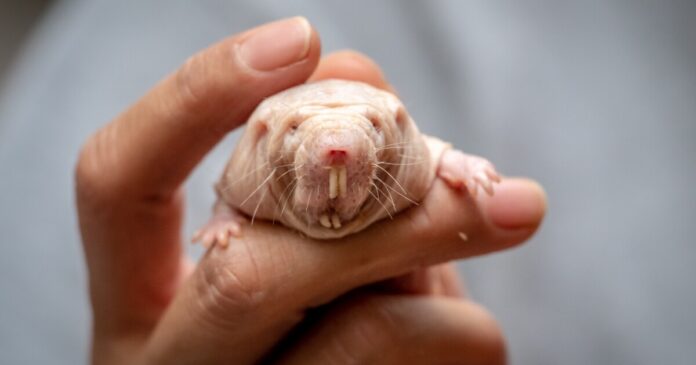What naked mole-rats lack in the looks department they make up for it in longevity, living healthily for nearly four decades. Now scientists have uncovered just how they repair their DNA – and it has the potential to be harnessed for humans to do the same.
Reseacher’s from Shanghai’s Tongji University have furthered our understanding of why these curious little rodents (Heterocephalus glaber) have such incredible lifespans, discovering that changes to four amino acid residues equip naked mole-rats with a kind of genetic toolbox that allows them to carry out repair jobs across their organs and prevent cell death (senescence).
Previously, scientists had found that the DNA sensor cyclic guanosine monophosphate–adenosine monophosphate synthase (cGAS) was driving this system-wide repair, patching up DNA double-strand breaks to stabilize the genome, but how this came to be has remained a mystery until now.
Using comparative molecular biology with human cGAS – which actually inhibits DNA repair – the scientists found that the naked mole-rat’s enzyme has four key changes that facilitate the important work that extends their lifespan and keeps them healthy and disease-free for a remarkably long time. When the rodent cGAS enzyme was inserted into human and mouse cells in the laboratory, the researchers observed that it significantly enhanced the cells’ ability to repair DNA and in turn reduced the molecular signs of aging. When they engineered fruit flies to produce the naked mole-rat’s cGAS, the insects lived around 10 days longer than expected. While this may not sound like much, these flies only live for around 40 days, so it’s a meaningful extension to their lifespan.
And when live mice were also equipped with the naked mole-rat cGAS, aging rodents were less frail, had less gray hair and had healthier organs for longer than animals in a control group.
“This alteration confers naked mole-rat cGAS with a greater capacity to stabilize the genome, counteract cellular senescence and organ aging, and promote extended lifespan and health span,” noted the researchers.
The next question is: could it translate to extending our own longevity and health span? Given the biological similarities between humans and naked mole-rats, the scientists believe so, equipping us with the ability to protect our genome from damage, disabling our cGAS from inhibiting the repair process. However, it’s admittedly a long way off – and the findings treat DNA repair as an isolated sign of aging, not taking into account other factors such as inflammation that contributes to disease and other age-related health issues.
“DNA sensor cyclic guanosine monophosphate–adenosine monophosphate synthase (cGAS) participates in regulating DNA double-strand break repair by suppressing the homologous recombination (HR) pathway, thereby promoting genomic instability,” the researchers noted. “Our work reveals that the negative regulatory function of cGAS in HR repair is reversed in the longest-lived rodent, the naked mole-rat, by an alteration of four specific amino acid residues. This alteration confers naked mole-rat cGAS with a greater capacity to stabilize the genome, counteract cellular senescence and organ aging, and promote extended life span and health span.”
Scientists have long been fascinated with the age-defying abilities of the African rodent, which spends its life in large colonies underground. Previous work has hit on clues as to why the naked mole-rat is able to stay healthy for so long, most notably how they appear to be protected from the onset of senescence – and researchers continue to search for how we can steal their anti-aging superpowers.
The study was published in the journal Science.
Source: Tongji University via Nature


